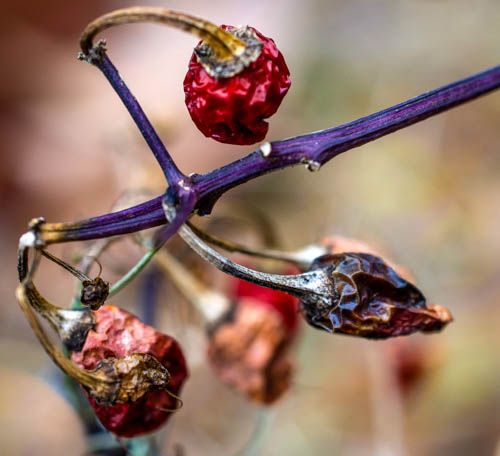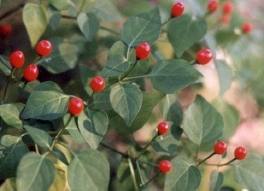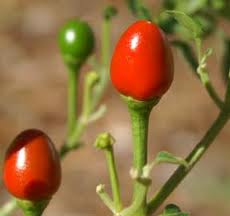
Wild peppers grow in many areas of Central and North America. The vary greatly and the exact species above is debatable. Photo by Green Deane
Capsicum annuum var. glabriusculum: Hot Eats
Did you know hot peppers grow in the wild? From Central American north to Arizona east to Florida then up the coast to New York and Connecticut.
Commonly called “bird peppers” they are properly Capsicum annuum var. glabriusculum. For a little pepper the birds defend bravely, it has gone a long ways.
Most of the natives of the Caribbean area called it some form of “aji” such as axi, aje, agi, asi et cetera. That held on as the Spanish moved in with aji bobito, aji caballero, aji caribe, aji chirel, aji chivato, aji guaguao, aji montesino, aji piante, and aji titi. However, the top dogs of the ancient Caribbean world were the Aztecs, and they called it ….chilli… and now you know. That led to more names, chile amash, chile bravo, chili de maonte, chile de zope, chile quimiche, chili siete caldos and chilillo.
They were originally named Capsicum annuum var. aviculare (annual peppers of the birds.) Birds, who have no need for botanist or nutritionists, know a good thing when they eat it. And bird peppers are good food. They have vitamins A and C, and a host of other compounds thought to prevent cancer and tumor. And they have heat.
Capsicum (KAP-sih-kum ) is from two Greek and Dead Latin words, Kapto, to bite, and capsa, a box, in reference to the fruit shape. Annuum (ANN-yoo-um) means annual, and glabriusculum (glab-ree-us- KYEW-lum) means completely without hair. Saying “chili peppers” is then redundant, as chili means those hot little peppers.
A bit of history. The word pepper comes from the Greek word pipari (pee-PAIR-ree) which means the black spice, which is botanically Piper nigrum (PYE-per NYE-grum ) which also means black pepper. For such a common item today it is difficult to stress how important black pepper was long ago. When the Goths sacked Rome in 410 AD among their demands were 5,000 pounds of gold and 3,000 pounds of black pepper. In the middle ages debts and dowries were paid with pepper corns. The pepper trade build Genoa and Venice, as well as Alexandra. It was a cartel similar to the diamond cartel today in which prices are kept intentionally high by a few suppliers. Chris Columbus’ trip to the New World was an attempt to break that cartel. And in fact, he did find “pepper” but gold fever took over.
Green Deane’s “Itemized” Plant Profile
IDENTIFICATION: Shrub, three to 10 feet tall, leaves ovate to ovate-lanceolate, pointed, one half to two inches long, sometimes much longer, four or five inches. Flowers white, yellow-green or lavender, five-lobed to half-inch wide. Fruit round, conical or elongated and pointed, one half-inch to an inch long, may change from white to yellow then purple to red, nearly hollow, a few small seeds, very pungent.
TIME OF YEAR: Seasonal in northern climes, year round in warmer areas
ENVIRONMENT: Hammocks, waste places, cultivated ground
METHOD OF PREPARATION: Ripe fruit as seasoning, leaves cooked as greens, rich in calcium, phosphorus, vitamins A and B. In Africa the fruits or leaves are eaten as an antidote if poisonous fish has been eaten.




I would love to have seeds from this plant! We don’t seem to have them here.
https://www.monticelloshop.org/
Texas Bird Peppers
7 years later. Wow. Just… wow.
I bought two small plants from Maple Street Natives in Melbourne, FL and have them in my backyard. I’m excited to try them in my raw veggie kraut. Thank you for this info Deane!
These come up in my yard every year in S. TX and ripen (red) in late fall to early winter. To say they are hot is an under statement, they are HOT! I make everything from Pico de Gallo to salsa to Hot Vinegar Sauce (Think Lousiana hot sauce) with them. Of course, I save a few to crush into the ground of my flower beds too. In Warm Winters, they will over winter and remain “evergreen”. Here’s a photo of them in varying degree’s of “ripeness”: http://www.flickr.com/photos/centavo/8304981866/
Nice photo of Bird Peppers.
Hi Dean,
Just a side note on a bit of research I just did on the name of a town near us – HOMOSASSA. I read that the name comes from Seminole/Creek meaning “where the wild pepper grows”…I see that may have been the Capsicum Annum var. glabriusculum…that is exciting.
NB: Hope all is well with you and yours…hope to be in another of your ‘walks’ this year.
Karen
In N.W. FL we have an abundance of a different plant I have always heard called Bird Peppers. The plants are thin branched with hundreds of small (smaller than a b.b.) flat, round green seed pods. The plants grow up to about 2′ high when they intrude into a garden area. The leaves are slender and about an inch long. Most of the plant, seed pods, and leaves are green. The bush has a pleasant aroma and the seed pods, when chewed, have a similar taste though stronger and with a tinge of hot. The root consists of a main tap root reminding me of an early turnip and has a good root system off that tuber. The roots are “woody” and not at all tender. I don’t know how to send them but I have photos. Any idea what the plant is actually named? Thank you.
You can go to the Green Deane forums https://www.eattheweeds.com/forum and post your pictures in the UFO (unidentified flowering object) thread. Please post one plant to a post. The many experts there will help you.
Hello. I am from Canada and spend the winters in Tolleson AZ (SW corner of Phoenix). I would love to buy an already started plant of this Bird Pepper (rather than seeds as I don’t think I have time for germinating and planting/getting established before I leave in April). If I could buy a plant I could “baby” it until April and hope that it would be established enough to survive until I come back again in the Fall. Thank you for any leads. Sheila.
Here in Dallas, birds seem to stake out the plants and then take the peppers on the very day they turn red. White-winged doves, in particular, seem to love them. They are very hot. I use them to add heat to salad dressings, pickles, etc. A little goes a long way, though, and they are so hot that you can’t use enough to really get any pepper flavor other than just the hotness. They may be tiny, but a whole one will easily render a pint jar of pickles too hot to eat.
Where did you find plant? I am suburb of Dallas/Fort Worth.
I actually want to know more about this birds pepper
How can I get it in Nigeria, West Africa
I’m in Nigeria and don’t know how to get d bird pepper.can u please help me to identify it here in Nigeria?
I don’t know how to get bird pepper in Nigeria
Where can I get bird pepper in Kaduna Nigeria.
Chili pequin bushes have always grown around my property both in the Rio Grande Valley and now here in Austin. All I had to do was plant one or two bushes from seed and the birds have done the rest, eating them and excreting them around the yard. They grow under the eaves of my house a lot too from birds pooping on the roof and the rain washing the seeds onto the ground. I love these little peppers. They pack a whole lotta heat for such a small pepper. I like to dry ’em and put them in an empty peppercorn grinder and grind some out over eggs, soups, sauteed squash, you name it. My dad makes a creamy hot sauce out of them that’ll make you smile and sweat at the same time.
Josey, I am a big fan of hot sauce and like to try your Dads recipe. Is it possible to get the recipe. Thanks Jimmy Richards
My mother and Grandmother have grown these for years.We were raised on Birds eye peppers my great Grandmother said our Indian ancestors used them for seasoning and medicine.If eaten raw at the right picking time I can believe that.Too many wil scare anything away
Which birds eat these peppers in Fl?